The First World War (1914-1918) recorded numerous battles that caused huge numbers of casualties.
As it is a global conflict, soldiers from five continents participated in some battles.
We highlight the disputes waged during the war either for strategic reasons or for its high number of fatalities.
1. Battle of Tannemberg
- Date: August 23rd to September 2nd
- Combat Fronts: Russia x Germany
- Location: East Prussia
- Result: German victory
- Write-offs: 160 thousand
- Prisoners of War: 100,000 Russians.

Historic
When World War I broke out, the Russian Second Army was given the command to invade West Prussia.
The Russian army, commanded by General Alexander Samsonov, slowly advanced through the southeast of the province. The aim was to join forces with General Paul von Rennankampf, who was advancing from the northeast.
The Russians initially fought successfully for six days. However, the Germans had more modern weapons and regained ground. When he realized he was at a disadvantage, General Samsonov tried to back down, but it was too late. In the face of defeat, the Russian general would end up committing suicide.
Only 10,000 of the 150,000 Russian soldiers managed to escape. In addition to the large number of prisoners, the Germans captured 500 Russian cannons. For its part, the German army lost 20,000 men.
The Battle of Tanneberg was the first in which two celebrated German generals would work together: Paul von Hindenburg, later president of the Weimar Republic and Erich Ludendorff.
2. First Battle of the Marne
- Date: September 5th to 12th, 1914
- Combat Fronts: Germany vs. France and the British Empire
- Location: river Marne, France
- Result: victory for allies France and British Empire
- Casualties: 250 thousand, with 80 thousand French soldiers dead and 12,733 English. The Germans suffered similar losses to the French.
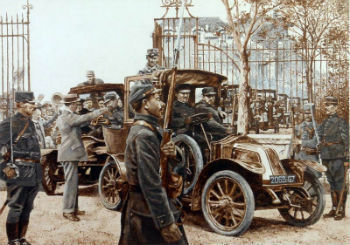
Historic
By the end of 1914, French and British forces were retreating on account of the German invasion. The German army left for Paris and the Allies beat a retreat.
On September 3, 500,000 French civilians left the French capital. The French army was ordered by General Joseph Joffre to line up along the Seine River.
Surveillance was maintained 60 kilometers south of the Marne River. The British Empire sent troops to assist in fighting the Germans.
On September 6, the French army attacked German forces. The Allies used taxis in Paris to get to the front lines.
The German army was commanded to retreat on 9 September. A day later, the battle came to an end with great loss and damage to both sides.
In this battle, the French realized the importance of using trenches in war. Before, they thought it dishonorable for a soldier to dig a hole and hide during a fight.
The Battle of the Marne marks a turning point in World War I:
- defeated by the Allies, the German Empire would have to fight on two fronts;
- France should change its military tactics;
- the Russian Empire would have to fight to regain the lost territories and drive out the German invader.
In this way, the hope that the conflict would end before Christmas was buried.
3. Battle of Gallipoli
- Date: April 25, 1915 to January 9, 1916
- Combat Fronts: Allies British Empire and France vs. Ottoman Empire
- Location: Gallipoli Peninsula and Dardanelles Strait in the Ottoman Empire (present-day Turkey)
- Result: Ottoman Empire Victory
- Casualties: 35,000 British, 10,000 Australians and New Zealanders, 10,000 French, 86,000 Turkish dead.
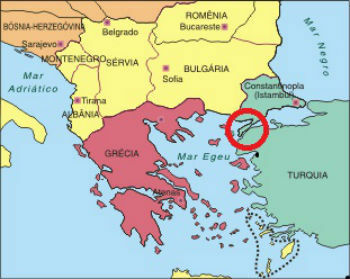
Historic
The British attacked the Turks on February 19, 1915. Bombings were launched into the Strait of Dardanelles with the aim of advancing through there and taking over the Gallipoli Peninsula.
The British Empire and France sent 18 warships to the combat region on 18 March. Three of the vessels were hit by mines and resulted in 700 deaths. There were also three other ships damaged.
To ensure that it would take the Gallipoli peninsula, the Allies sent more soldiers into the region. This time, the British Empire supplied the front with 70,000 men from Australia and New Zealand.
The reinforcements also had French soldiers. The attack began on April 25, 1915 and the Allies withdrew in January 1916, after their troops had been decimated.
One of those responsible for this carnage was the First Lord of the Admiralty, Winston Churchill who resigned after the episode.
4. Battle of Jutland
- Date: May 31 and June 1, 1916
- Combat Fronts: British and Germans
- Middle: Naval
- Location: North Sea, near Denmark
- Result: Inconclusive. Both sides claimed victory. Tactically, Germany won and, strategically, the British Empire
- Casualties: 6,094 British and 2,551 German.
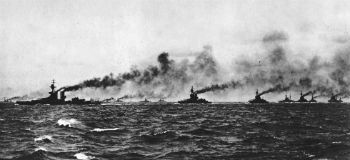
Historic
This was the greatest naval battle in World War I and in history. It involved the two largest naval fleets in the world, the British and the German, in a dispute on the high seas.
The combat included 100,000 men and 250 British and German warships.
Germany's aim was to defeat the superiority of the British Empire at sea. The fighting began when the commander of the German fleet, Reinhardt von Scheer, sent 40 ships to the North Sea.
English command was exercised by David Beatty and John Jellicoe, who witnessed the sinking of three ships on the first day of battle.
However, the losses did not make them give up the fight. The British Empire fleet maneuvered to block the way back from the Germans, who fled north.
The British Empire lost 6,784 men and 14 ships totaling 110,000 tons. Among the Germans, 3,058 soldiers died and the loss of 11 ships totaling 62,000 tons succumbed to British bombing.
On many of these ships there were no survivors.
Like almost all conflicts of World War I, this battle had a very high human and material cost. The German Empire was victorious, but thanks to British propaganda, the British also considered themselves victorious.
At the end of the confrontation, the Allies maintained the blockade, and Germany would not again attempt a sea battle of this magnitude. This tactic was decisive in ending the war and defeating the Germans.
5. Battle of Verdun
- Date: February 21st to December 20th, 1916
- Fighting Fronts: Germany vs. France
- Location: Verdun, France
- Result: French victory
- Casualties: 1 million injured or missing. There were about 450,000 deaths on both sides.
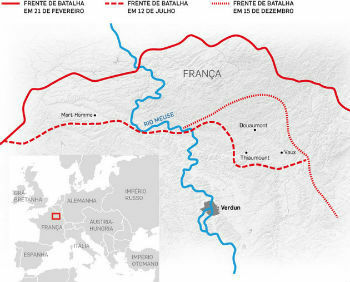
Historic
The Battle of Verdun started after the German Empire decided to take the war towards the West and not against Russia in the East.
The goal was to attack the French and try to negotiate peace separately. The strategy went wrong and there was an intense reaction from the French, who came out victorious.
The Germans advanced quickly and entered the field with 143,000 soldiers. The French defense had 63,000 men.
This battle is called by unflattering names like "French mass grave" and "Meat grinder." The referral occurs on account of the number of victims. There were 450,000 deaths in almost 300 days of combat.
6. Somme's Battle
- Date: July 1st to November 18th, 1916
- Combat Fronts: British and French Allied Forces Against Germany
- Location: Somme, Picardy region, France
- Result: Allied Forces Victory
- Casualties: 600,000 Allied and 465,000 German casualties. A third of the soldiers died.
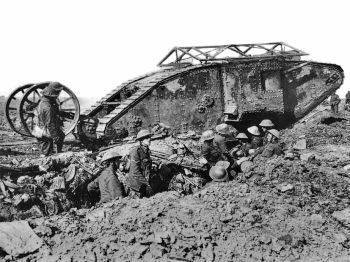
Historic
The battle of Somme is considered one of the bloodiest of the First World War.
On December 6, 1915 the Allies decided to take joint action against the Germans whose aim was to contain the German army's advance in the area.
The British Empire ordered the reinforcement of the French troops fighting in Verdun. With an unprepared troop, made up mostly of volunteers, 19,000 Britons died on the first day of combat alone.
German soldiers, in turn, used flamethrowers to attack the opposing trenches. On the second day of the battle alone, they took some 3,000 prisoners among the Allies.
Casualties were not enough to motivate the British command to retreat. To strengthen the front, soldiers were sent from British colonies such as Australia, South Africa, New Zealand and Canada. The reinforcement gave good results and the Germans lost 250,000 men by August.
Germany was also at a disadvantage because the British Empire's fleet of ships surrounded the North Sea and the Adriatic Sea, preventing the country from receiving food. The measure created severe food shortages for the Germans.
War tanks were used for the first time in this combat. The British army used 48 Mark I tanks, but only 21 made it to the front as the rest broke down along the way.
Also in this fight, the German adolf hitler was injured and hospitalized for two months.
7. Third Battle of Ypres
- Date: July 31st to November 10th, 1917
- Fighting fronts: British Empire, Belgium and France against Germany
- Location: West Flanders, Belgium
- Result: Allied Forces Victory
- Casualties: 857.1 thousand dead and missing.

Historic
The Battle of Ypres was also called the Battle of Passchendaele. The fighting involved Canadian, British and South African soldiers against the Germans. The battle is estimated to have involved 4 million soldiers on both sides.
The objective was to control the southern and eastern parts of Ypres, considered strategic by the allies. After the conquest, the Allies planned to advance to Thouront and block the German-controlled railway.
The conflict took place in the summer that was particularly rainy that year. When the battle started, British aviation could not participate in the bombing due to fog.
During the battle, 136 tanks were used, of which only 52 managed to advance over the muddy terrain. However, this time, these vehicles were of little use as 22 broke down and 19 were put out of action by the Germans.
The German army resisted, even in the very wet weather. However, they began to face riots in the navy and army, which weakened the morale of the troops.
As neither side was able to advance, the Allies changed their strategy by focusing their efforts on a few points. In this way, the Germans retreated and the Canadians took Ypres.
There were also the fourth and fifth battles of Ypres.
8. Battle of Caporetto
- Date: October 24th to November 12th, 1917
- Fighting fronts: Germany and Austria-Hungary against Italy
- Location: Kobarid, present-day Slovenia
- Result: victory for the army of Germany and Austria-Hungary
- Casualties: 10 to 13 thousand Italians and 50 thousand Germans and Austrians.
- Prisoners of War: 260,000 Italian prisoners who surrendered voluntarily.
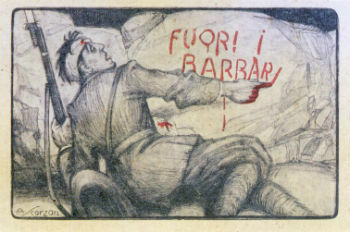
Historic
Caporetto was just a small town like so many others, but after the battle it became synonymous with defeat.
German and Austrian forces employed trench warfare tactics, used poison gas. They still had the help of the weather conditions, as the fog helped them to advance. The result was 11,000 Italian soldiers killed and 20,000 wounded.
As the lines of communication were cut, the Italian General Staff was unable to communicate with its officers. Without command, soldiers surrendered en masse in order to escape certain death.
More than a million civilians also fled in fear of the invasion's consequences.
The Germans and Austro-Hungarians managed to advance more than 100 km towards Venice. Germany was only stopped when the army approached the Piave River.
In this region, the French, British and American allies blocked the offensive.
9. Battle of Cambrai
- Date: November 20th to December 7, 1917
- Combat Fronts: Allied Forces of the British Empire and the United States against Germany
- Location: Cambrai, France
- Result: victory for the British
- Write-offs: 90 thousand.

Historic
The British Empire War Command applied new infantry and artillery tactics in this battle. The objective was to take the Hindenburg Line and get close to the summit of Bourlon. That way it would be easier to threaten the German army.
The battle was marked mainly by artillery and infantry combat. Among the strategies was to use tanks to destroy the barbed wire fences used in the trenches by the Germans.
The tactic worked and the British managed to penetrate 1000 km of German lines and take 10,000 prisoners. This time, the tanks were essential to guarantee the advance of the troops.
It was the first quick and convincing victory in a war in which it was difficult to judge who won the battles. This helped boost British morale.
10. Battle of Amiens
- Date: August 8th to 12th, 1918
- Combat Fronts: Allied forces of France, the United States and the British Empire against Germany
- Location: east of Amiens, Picardy, France
- Result: decisive victory for allied forces
- Casualties: 52,000 between dead and missing
- Prisoners of War: 27,800.
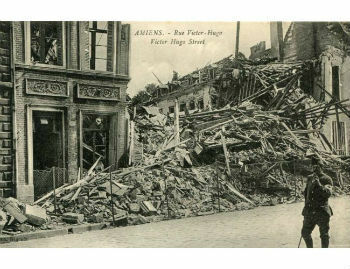
Historic
It is also known as the Third Battle of Picardy. This confrontation marks the beginning of the Hundred Day Offensive, which marked the end of the First World War.
The Allies were living in a special moment, as the Americans had joined them in the war and American troops were already on European soil. Likewise, they reaped victories in the Balkans and the Middle East.
On the other hand, the German Empire had signed peace with Russia in the Brest-Litovski Treaty and could concentrate all forces on the western front. However, they had the problem of finding themselves abandoned by their allies.
On the very first day, the British managed to advance 11 km and make several arrests among the surrendering Germans. This gave life to other points of combat by restarting battles in Verdun, Arras and Noyons.
Worn out and unable to fight, the Germans asked for an armistice on November 11, 1918.
Despite marking the beginning of the end of the great war, the Hundred Days Offensive, begun in Amiens, leaves impressive numbers: almost 2 million people lost their lives in just over 3 months of fight.
read more:
- First World War
- Causes of the First World War
- war of trenches
- Phases of the First World War
- Consequences of the First World War
- Brazil in World War I
- Questions about the First World War
- Movies about the First World War

